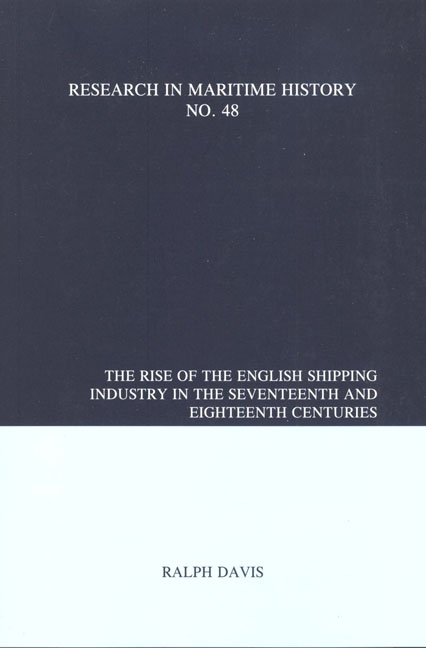Book contents
- Frontmatter
- Contents
- Introduction to the 2012 Edition
- Series Editor's Note
- Introduction
- Preface
- Chapter 1 The Widening of Horizons, 1560-1689
- Chapter 2 Consolidation, 1689-1775
- Chapter 3 Ships and Shipbuilders in the Seventeenth Century
- Chapter 4 Ships and Shipbuilders in the Eighteenth Century
- Chapter 5 The Shipowners
- Chapter 6 The Merchant Seamen
- Chapter 7 The Pay and Conditions of Merchant Seamen
- Chapter 8 Shipping Management and the Role of the Master
- Chapter 9 Shipping and Trade
- Chapter 10 The Nearby and Northern European Trades
- Chapter 11 The Southern European and Mediterranean Trades
- Chapter 12 The East Indian Trade
- Chapter 13 The American and West Indian Trades
- Chapter 14 The Government and the Shipping Industry
- Chapter 15 War and the Shipping Industry
- Chapter 16 Four Ships and Their Fortunes
- Chapter 17 Was It a Profitable Business?
- Chapter 18 Conclusion
- Appendix A A Note on the Shipping Statistics, 1686-1788
- Appendix B Sources for the History of the Shipping Industry
- Index
Chapter 13 - The American and West Indian Trades
- Frontmatter
- Contents
- Introduction to the 2012 Edition
- Series Editor's Note
- Introduction
- Preface
- Chapter 1 The Widening of Horizons, 1560-1689
- Chapter 2 Consolidation, 1689-1775
- Chapter 3 Ships and Shipbuilders in the Seventeenth Century
- Chapter 4 Ships and Shipbuilders in the Eighteenth Century
- Chapter 5 The Shipowners
- Chapter 6 The Merchant Seamen
- Chapter 7 The Pay and Conditions of Merchant Seamen
- Chapter 8 Shipping Management and the Role of the Master
- Chapter 9 Shipping and Trade
- Chapter 10 The Nearby and Northern European Trades
- Chapter 11 The Southern European and Mediterranean Trades
- Chapter 12 The East Indian Trade
- Chapter 13 The American and West Indian Trades
- Chapter 14 The Government and the Shipping Industry
- Chapter 15 War and the Shipping Industry
- Chapter 16 Four Ships and Their Fortunes
- Chapter 17 Was It a Profitable Business?
- Chapter 18 Conclusion
- Appendix A A Note on the Shipping Statistics, 1686-1788
- Appendix B Sources for the History of the Shipping Industry
- Index
Summary
The English colonies in America divide economically into two groups. On the one hand are the plantation colonies - the tropical islands and the warm middle colonies of the mainland; the West Indies, Florida and Georgia, the Carolinas, Virginia and Maryland. These were very largely dependent on the production of staple export crops for Europe. On the other, there are the colonies from Pennsylvania northward, places of small farming and lumbering settlements, which always had difficulty in procuring suitable goods to send to England in exchange for the manufactures they required. Of all the areas which demanded the services of English shipping during the seventeenth and eighteenth centuries, the plantation colonies of America grew most consistently and most rapidly in importance, and by 1775 the traders with them were by far the biggest customers of the English shipping industry. They must provide the main theme of this chapter. The northern colonies traded with England in quite small volume, and to an increasing extent in ships owned in the ports of New England; they will be dealt with briefly at the end.
Permanent English settlement in America began on the shores of Chesapeake Bay in 1607, was extended to New England in the next decade and to the West Indian islands in the twenties; by 1632 Barbados, Nevis, Montserrat, Antigua and part of St. Kitts were occupied. On the American mainland settlement spread steadily inland and along the coast; the islands were taken in leaps, Jamaica in 1655 and St. Vincent, Dominica, St. Lucia and Tobago at various dates before 1763, when they were formally annexed. The early colonies all grew food crops for their own support, but within a few years Virginia found its export staple in tobacco; the West Indian settlers quickly followed suit, and fast-growing tobacco production caused a collapse of tobacco prices in the twenties and thirties. After some years of uncertainty and experiment with such crops as ginger, cotton and indigo, the West Indies found their true fortune when Barbados planters, influenced by Dutch expelled from Brazil, began about 1640 the cultivation of sugar cane. Other islands followed, though slowly and less wholeheartedly, and by 1660 sugar was the principal crop throughout the West Indies, and was everywhere encroaching on the lands formerly devoted to other products.
- Type
- Chapter
- Information
- The Rise of the English Shipping Industry in the Seventeenth and Eighteenth Centuries , pp. 257 - 288Publisher: Liverpool University PressPrint publication year: 2012



